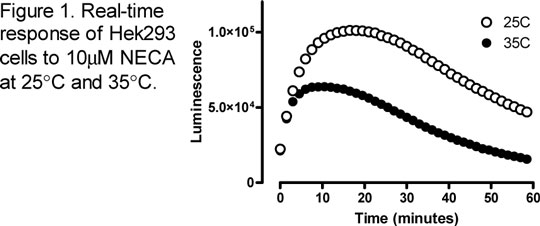Measurement of real-time changes in intracellular cAMP levels in HEK 293 cells in response to adenosine A2-receptor activation using a GlosensorTM assay GloSensorTM (Promega) is a novel high-throughput assay which offers the potential for real-time and live-cell analysis of cAMP production. Whilst cAMP production is a common measure of Gs and Gi coupled GPCR signalling, it is generally monitored as an end-point assay rather than as a dynamic read-out in living cells. The GloSensorTM assay [Fan et al., 2008] is based on an engineered firefly luciferase enzyme, incorporating a cAMP binding moiety, which has been stably expressed in HEK293 cells. Here we explore the influence of temperature on cAMP-induced bioluminescence activity in response to forskolin (FSK), N-ethylcarboxamidoadenosine (NECA) and the membrane permeable cAMP analogue, 8-(4-chlorophenylthio) adenosine 3’, 5’-cyclic monophosphate sodium salt (8-CPT).
GloSensorTM HEK293 cells were seeded in 96-well white-walled plates, left overnight then incubated at 25°C or 35°C in atmospheric CO2 for 2hr in 100μL HBSS containing 4% GloSensorTM cAMP reagent. Luminescence was measured on Envision (PerkinElmer) for 1hr at 25°C or 35°C with or without the addition of FSK, NECA or 8-CPT to achieve final concentrations ranging from 10nM to 100μM. Antagonist pre-treatment involved exposure to XAC or ZM241385 (10-8-10-5mol/L) for 30 minutes at 25°C prior to NECA addition (10μM).
FSK, NECA and 8-CPT elicited a concentration dependent increase in luminescence which was generally characterised by a fall following achievement of peak. An increase in temperature caused a consistent enhancement in the rate of increase of luminescence; however the size of the peak response was very dependent on the assay temperature, with much larger responses seen at the lower temperature.
The response to NECA (10μM) was antagonised by pre-incubation with either XAC or ZM241385, pIC50 of 6.0±0.1, and 6.4±0.1 respectively (n = 3); suggesting that the NECA stimulation of cAMP in HEK293 GlosensorTM cells is mediated by an A2 receptor.
Table 1. pEC50 values for FSK, NECA and 8-CPT (n = 3).

Fan et al., (2008) ACS Chemical Biology, 3:346-351. |
|||||||||||||

